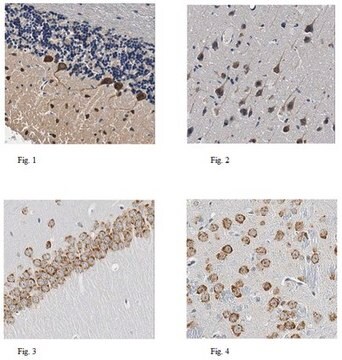おすすめの製品
由来生物
hamster (Armenian)
結合体
PE
抗体製品の状態
affinity isolated antibody
抗体製品タイプ
primary antibodies
クローン
145-2C11, monoclonal
化学種の反応性
mouse
テクニック
activity assay: suitable
flow cytometry: suitable
immunohistochemistry: suitable
immunoprecipitation (IP): suitable
western blot: suitable
アイソタイプ
IgG
UniProtアクセッション番号
輸送温度
wet ice
ターゲットの翻訳後修飾
unmodified
遺伝子情報
mouse ... Cd3E(12501)
詳細
CD3, also known as T3, is a member of the Ig and the ITAM superfamilies. The CD3 complex is composed of six polypeptides with usually four different transmembrane CD3 chains, gamma, delta, epsilon and zeta. CD3 is primarily expressed on T cells, NK-T cells, and at different levels on thymocytes during T cell differentiation. CD3 plays a critical role in TCR signal transduction, T cell activation, and antigen recognition by binding the peptide/MHC antigen complex. The CD3 antigen is present in early thymocytes, and has been considered the best all-around T cell marker. The positive staining of this marker may represent a sign of early commitment to the T cell lineage. In cortical thymocytes, during early stages of maturation, the CD3 antigen is predominantly present in the cell cytoplasm. In medullary thymocyles, the CD3 antigen is predominantly detected on the cell surface. The majority of T cell neoplasms also expresses CD3, but it is absent from non-T-cell lymphoid malignancies. CD3 complex plays an important role in coupling antigen recognition to several intracellular signal-transduction pathways. The genes encoding the epsilon, gamma and delta polypeptides are located in the same cluster on chromosome 11. The epsilon polypeptide plays an essential role in T-cell development. Defects in this gene cause immunodeficiency. This gene has also been linked to a susceptibility to type I diabetes in women.
アプリケーション
Anti-CD3ε (mouse) Antibody, PE, clone 145-2C11 is a highly specific armenian hamster monoclonal antibody, that targets CD3ε & has been tested in Flow Cytometry, IHC, Activity Assay, IP & western blotting.
品質
The antibody was purified by affinity chromatography, and conjugated with PE under optimal conditions. The solution is free of unconjugated PE and unconjugated antibody.
Flow Cytometry Analysis: 0.25 μg of this antibody detected CD3ε in one million C57BL/6 mouse splenocytes.
Flow Cytometry Analysis: 0.25 μg of this antibody detected CD3ε in one million C57BL/6 mouse splenocytes.
ターゲットの説明
21 kDa calculated
その他情報
Concentration: Please refer to the Certificate of Analysis for the lot-specific concentration.
適切な製品が見つかりませんか。
製品選択ツール.をお試しください
保管分類コード
10 - Combustible liquids
WGK
WGK 2
適用法令
試験研究用途を考慮した関連法令を主に挙げております。化学物質以外については、一部の情報のみ提供しています。 製品を安全かつ合法的に使用することは、使用者の義務です。最新情報により修正される場合があります。WEBの反映には時間を要することがあるため、適宜SDSをご参照ください。
Jan Code
MABF317:
試験成績書(COA)
製品のロット番号・バッチ番号を入力して、試験成績書(COA) を検索できます。ロット番号・バッチ番号は、製品ラベルに「Lot」または「Batch」に続いて記載されています。
M R Goodier et al.
Journal of immunology (Baltimore, Md. : 1950), 165(1), 139-147 (2000-06-22)
NK cells recognize and kill tumor cells and normal cells, and these play an important role in immune defense in cancer, infectious disease, and autoimmunity. NK killing is regulated by positive or negative signals derived from the interaction of surface
Wengang Wang et al.
Journal of immunology (Baltimore, Md. : 1950), 178(8), 4885-4890 (2007-04-04)
Sphingosine 1-phosphate (S1P) is a natural lipid mediator that regulates immune cell traffic, Ab production, and T cell cytokine generation by mechanisms that enhance Th2 activities. Responses to S1P are controlled principally by the diverse expression patterns of its receptors
Stephen L Tilley et al.
Journal of immunology (Baltimore, Md. : 1950), 178(5), 3208-3218 (2007-02-22)
The retinoid-related orphan receptors (ROR) comprise a distinct subfamily of nuclear receptors with the capacity to act as both repressors and activators of transcription. RORgamma, the most recently identified member of the ROR family, has been shown to be important
Fc receptor binding of anti-CD3 monoclonal antibodies is not essential for immunosuppression, but triggers cytokine-related side effects.
Vossen, A C, et al.
European Journal of Immunology, 25, 1492-1496 (1995)
Role of the programmed Death-1 pathway in the suppressive activity of alternatively activated macrophages in experimental cysticercosis.
Terrazas, Luis I, et al.
International Journal For Parasitology, 35, 1349-1358 (2005)
ライフサイエンス、有機合成、材料科学、クロマトグラフィー、分析など、あらゆる分野の研究に経験のあるメンバーがおります。.
製品に関するお問い合わせはこちら(テクニカルサービス)